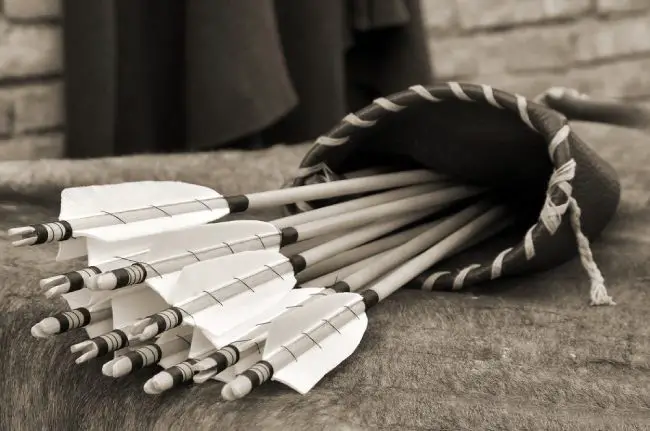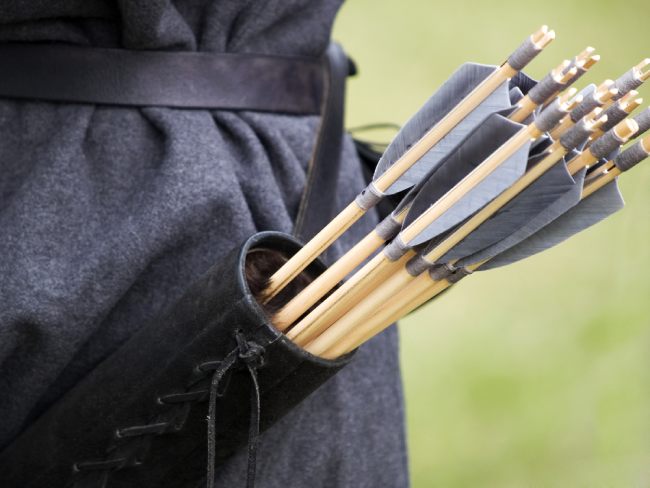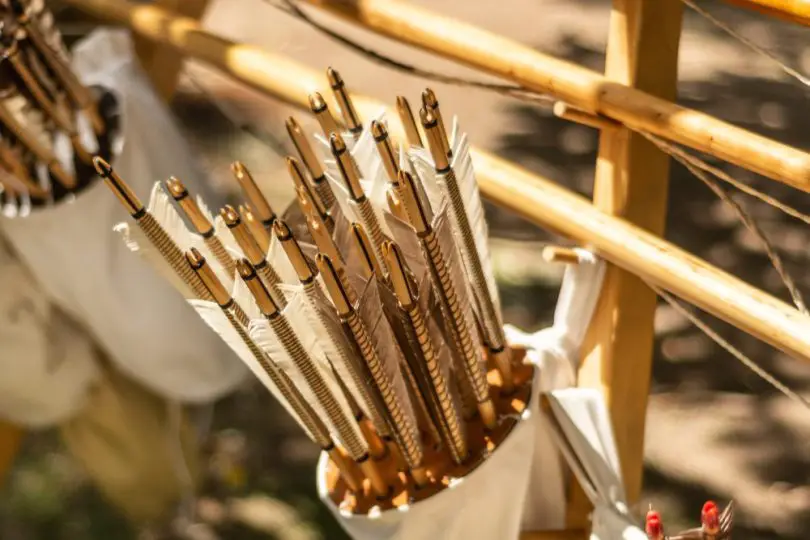There are different types of quivers with different arrow holding capacities. This means we cannot give you an exact answer to the question – how many arrows are in a quiver?
However, we will take a look at the arrow capacity of different types of quivers and factors that impact the capacity of a quiver. By the time you are done going through this blog, you will have a clear idea about what type of quiver to choose for your own archery preference.
How Many Arrows are in a Quiver? – Based on Quiver Type

1. Field quivers
Comfortable for long shooting sessions, field quivers usually hold 12 arrows though the number can reach up to 24. They are great for compound bows although you will also sometimes find them being used for recurve bows. Some field quivers have additional compartments or pockets to accommodate other accessories e.g. spare tips or fletchings.
2. Hip quivers
Hip or side quivers can hold 8 to 12 arrows and are designed to be compact and easy to access while moving so you can quickly retrieve and shoot them. The nosier design allows you to hold some gear in it as well, such as gloves or tabs.
3. Back quivers
Back quivers may be noisy and your arrows may fall out if you somehow lean forward too much. But with a capacity of 20 to 30 arrows they are the champions when it’s about accommodating the highest number of arrows in a bow quiver.
Back quivers are designed to distribute the weight of the arrows evenly and allow for easy access. They usually have a single main compartment for arrows, although some have additional pockets or compartments for accessories.
4. Tube quivers
Tube quivers are attached to your belt and can be noisy and swing around while you move. They have a limited capacity for holding arrows, which depends on the number of tubes they have.
However, they are very affordable and great for beginners or young children! Usually, each tube can hold around three arrows, but it may vary depending on the size of the arrows.
5. Traditional quivers
Traditional quivers are a whole new ballgame that depends on the type of bow an archer is using. Different types of traditional quivers serve different purposes. For instance, the korean or machu style quivers allow for movement.
In general, they can hold around 10 to 20 arrows while some may have a smaller or a larger capacity.
6. Bowhunting quivers
Bowhunting quivers are attached to the bow itself. Unless you are going hunting, you may not need to use them. The advantage of using a bow-mounted quiver is that it keeps your arrows quiet and easily accessible. However, it can be slower to put the arrows back into the quiver, and it adds weight to your bow.
These quivers are mostly used with compound bows, although some recurve bows can also accommodate them. The number of arrows these quivers can hold is limited to the available slots or compartments in the quiver.
7. Thumb ring quivers
They are used in traditional Mongolian and Turkish archery where arrows are stored on the thumb ring itself. These quivers can hold a smaller number of arrows, usually 3 to 5.
8. Pocket quivers
Usually used for hunting or backyard shooting, pocket quivers can hold around 6 arrows though the small carbons can fit around 12. They may move back and forth and hit your back while making it hard to put your arrows away.
9. Ground quivers
A ground quiver is designed to hold a larger number of arrows and is typically used in target shooting or field archery. These quivers can hold 40 to 50 arrows or even more.
How Many Arrows are in a Quiver? – Based on Purpose
For archery drills
For practicing leisure archery at home or in your backyard, we recommend that you have at least a dozen arrows. Having multiple arrows allows you to shoot multiple times without constantly retrieving your arrows.
It also helps to have extras in case some arrows get damaged or lost. So, having around 12 to 24 arrows should be a good range to start with for practice archery.
For competition
The number of arrows you can carry in an archery competition will be determined by the authority but you can expect around two to three dozen arrows.
For hunting
For bowhunting, you need extra arrows in case you miss your target, lose an arrow, or if any of your arrows get damaged during the hunt. So, having around 6 to 12 arrows is a good range to start with.
Factors that Determine the Arrow Capacity of a Quiver

Quiver design
The design of the quiver itself plays a significant role in determining its arrow capacity. As you have already seen, quivers come in different shapes and sizes, and the number of arrows they can hold depends on factors such as the length and diameter of the tubes or compartments.
Quiver size
The physical size of the quiver will impact its capacity. Larger quivers have more room to accommodate a greater number of arrows while smaller ones have a more limited capacity.
Quiver type
Different types of quivers have different capacities. As mentioned earlier, back quivers, side quivers, ground quivers, bow quivers, and thumb ring quivers all have different capacities based on their intended use and design.
Arrow length
The length of the arrows you intend to carry also matters here. Longer arrows require more space within the quiver, which may reduce the total number of arrows it can hold.
Arrow diameter
You need to count the diameter or thickness of the arrows as well. Thicker arrows take up more space within the quiver and reduce the overall capacity.
Arrow fletching
The type of fletching on the arrows, such as feathers or plastic vanes, can affect how closely they can be stored together in the quiver. Arrows with larger fletchings will require more space.
A Brief Look at the History of Archery Quivers
Archery quivers have a long history that goes back thousands of years. The word “quiver” comes from an old French word, “quiver,” which means “case for arrows.”
The earliest known quivers were made of natural materials like animal hides, reeds, or woven baskets. These early quivers were often slung over the shoulder or attached to a belt for easy access to the arrows.
As civilizations advanced, so did the design and materials of quivers. In ancient Egypt, archers used quivers made of leather or cloth that were worn on the back. They had straps to secure them and protect the arrows.
During the Middle Ages, quivers became more elaborate. They were often made of leather and beautifully decorated with embroidery or metal accents. These quivers were worn on the back, hung from the waist, or attached to a saddle.
Quivers took on unique styles in different parts of the world. Mongolian archers, for instance, used a distinctive quiver called a “gorytus.” It was made from animal skin and the arrows were placed inside with the fletchings facing upward. This allowed the archers to quickly grab the arrows and shoot without wasting time adjusting them.
As time progressed, quivers also evolved to accommodate different types of archery. In modern target archery, quivers are often designed to hold arrows vertically with separate compartments to keep them organized.
The history of archery quivers showcases the ingenuity and adaptability of humans throughout the ages. From simple containers made of natural materials to sophisticated designs, the quiver has played an essential role in the sport of archery, ensuring that archers have easy access to their arrows when they need them.
Wrapping it up
Now that you know how many arrows are in a quiver, we believe you will now be able to make the right quiver choice that will ultimately help take your archery skill to the next level.
FAQs
1. Are there quivers suitable for left-handed archers?
Ans. Yes, many quivers are designed to be ambidextrous, meaning they can be used by both right-handed and left-handed archers.
2. Can I use a quiver for other purposes?
Ans. While archery quivers are primarily designed for carrying arrows, some people repurpose them for different uses. They can be used to hold items such as pens, tools, or small fishing gear. But remember that modifying or repurposing a quiver may affect its functionality and durability.
3. Can I carry broadhead arrows in a quiver?
Ans. Some quivers are specifically designed to accommodate broadhead arrows with separate compartments or foam inserts to protect the arrows and prevent accidental injury.









Leave a Comment